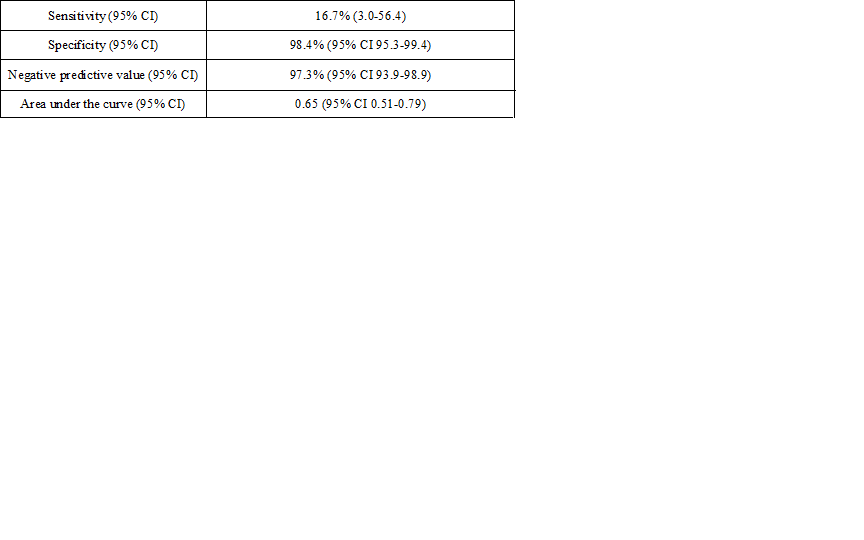Emergency Medicine: All Areas
Category: Abstract Submission
Emergency Medicine VII
370 - Is an urine culture mandatory in all febrile neutropenic Pediatric patients with cancer?
Saturday, April 23, 2022
3:30 PM - 6:00 PM US MT
Poster Number: 370
Publication Number: 370.206
Publication Number: 370.206
José Antonio Alonso Cadenas, Pediatric Emergency Department, Niño Jesús Children University Hospital, Madrid, Madrid, Spain; Monica Sancosmed Ron, Hospital Vall Hebron Barcelona, viladecans (barcelona), Catalonia, Spain; Blanca Herrero Velasco, H. Infantil universitario del niño jesus, Madrid, Madrid, Spain; Esther Lera Carballo, Vall d'Hebron Hospital, Cornella de Llobregat (Barcelona), Catalonia, Spain; Alvaro Lassaletta, Hospital Univeristario Infantil Niño Jesus, Madrid, Madrid, Spain; Rocío Rodrigo García, AdventHealth for Children, Barcelona, Catalonia, Spain; Mercedes de la Torre Espí, H. Infantil Universitario Niño Jesús, Madrid, Madrid, Spain
.jpg)
José Antonio Alonso Cadenas (he/him/his)
Pediatric Emergency Physician
Pediatric Emergency Department. Niño Jesús University Hospital
Madrid, Madrid, Spain
Presenting Author(s)
Background: Fever during chemotherapy-induced neutropenia is often the only sign of an infection. The most common documented infection is bacteremia, followed by gastrointestinal, respiratory and urinary tract infection (UTI). Algorithmic approaches and guidelines for febrile neutropenia mandate blood analysis and culture. It is controversial if other cultures as urine culture (UC) should be performed routinely.
Objective: To evaluate the need for obtaining routinely urine studies in febrile neutropenic children with cancer.
Design/Methods: A prospective study conducted on Pediatric cancer patients with urinary continence who presented to the emergency department with febrile neutropenia between October 2019 and November 2021 was performed. Children were divided into 3 groups: group 1 [positive UC, negative blood culture (BC)], group 2 (negative UC, positive BC) and group 3 (both negative cultures). Fever was considered as an axillary temperature >37.8ºC on 1 measurement or >37.5ºC on 2 or more occasions during a 1-hour period. Neutropenia was defined as an absolute neutrophil count (ANC) of < 500 cells/mm3 or an ANC expected to decrease to < 500 cells/mm3 during the next 48 hours. Leukocyturia was considered as >5 white cells/high-power field. Cut-off was used for positive UC: ≥105 cfu/mL (sterile collected). A descriptive analysis are provided. Sensitivity, specificity, the negative predictive value (NPV) and area under the curve (AUC) for the urinalysis were calculated with a positive urine culture as the gold standard.
Results: The study included 191 patients. Mean age was 9.2±5.0 years. UTI was found in 6 febrile neutropenia episodes (3.1%): 3 Pseudomonas aeruginosa, 1 E. coli, 1 Enterobacter cloacae, and 1 Enterococcus faecalis. Two patients had a previous history of kidney disease (kidney transplant and a carrier of a double-J catheter). One of these two patients was the only one who had urinary symptoms and leukocyturia in the urinalysis. The prevalence of UTI in patients without localizing signs nor urinary tract abnormalities was 2.2% (4/180), all of them with normal urinalysis. Twenty patients (10.5%) had bacteremia, none of whom had a UTI. The following variables assessed in all 3 groups are shown in table 1. Characteristics of urinalysis are shown in Table 2.Conclusion(s): UTI is an infrequent cause of infection in febrile neutropenic children with urinary continence and cancer. Urine study should be not performed routinely in patients without a kidney disease history but if it is obtained, UC should be collected regardless of the result of the urinalysis.
Table 1. Maximum temperature and laboratory findings in all 3 groups.png) SD:standard deviation; ANC: absolute neutrophil count.
SD:standard deviation; ANC: absolute neutrophil count.
Table 2. Sensitivity, specificity, the negative predictive value and area under the curve for the urinalysis. CI: confidence interval.
CI: confidence interval.
Objective: To evaluate the need for obtaining routinely urine studies in febrile neutropenic children with cancer.
Design/Methods: A prospective study conducted on Pediatric cancer patients with urinary continence who presented to the emergency department with febrile neutropenia between October 2019 and November 2021 was performed. Children were divided into 3 groups: group 1 [positive UC, negative blood culture (BC)], group 2 (negative UC, positive BC) and group 3 (both negative cultures). Fever was considered as an axillary temperature >37.8ºC on 1 measurement or >37.5ºC on 2 or more occasions during a 1-hour period. Neutropenia was defined as an absolute neutrophil count (ANC) of < 500 cells/mm3 or an ANC expected to decrease to < 500 cells/mm3 during the next 48 hours. Leukocyturia was considered as >5 white cells/high-power field. Cut-off was used for positive UC: ≥105 cfu/mL (sterile collected). A descriptive analysis are provided. Sensitivity, specificity, the negative predictive value (NPV) and area under the curve (AUC) for the urinalysis were calculated with a positive urine culture as the gold standard.
Results: The study included 191 patients. Mean age was 9.2±5.0 years. UTI was found in 6 febrile neutropenia episodes (3.1%): 3 Pseudomonas aeruginosa, 1 E. coli, 1 Enterobacter cloacae, and 1 Enterococcus faecalis. Two patients had a previous history of kidney disease (kidney transplant and a carrier of a double-J catheter). One of these two patients was the only one who had urinary symptoms and leukocyturia in the urinalysis. The prevalence of UTI in patients without localizing signs nor urinary tract abnormalities was 2.2% (4/180), all of them with normal urinalysis. Twenty patients (10.5%) had bacteremia, none of whom had a UTI. The following variables assessed in all 3 groups are shown in table 1. Characteristics of urinalysis are shown in Table 2.Conclusion(s): UTI is an infrequent cause of infection in febrile neutropenic children with urinary continence and cancer. Urine study should be not performed routinely in patients without a kidney disease history but if it is obtained, UC should be collected regardless of the result of the urinalysis.
Table 1. Maximum temperature and laboratory findings in all 3 groups
.png) SD:standard deviation; ANC: absolute neutrophil count.
SD:standard deviation; ANC: absolute neutrophil count.Table 2. Sensitivity, specificity, the negative predictive value and area under the curve for the urinalysis.
 CI: confidence interval.
CI: confidence interval.